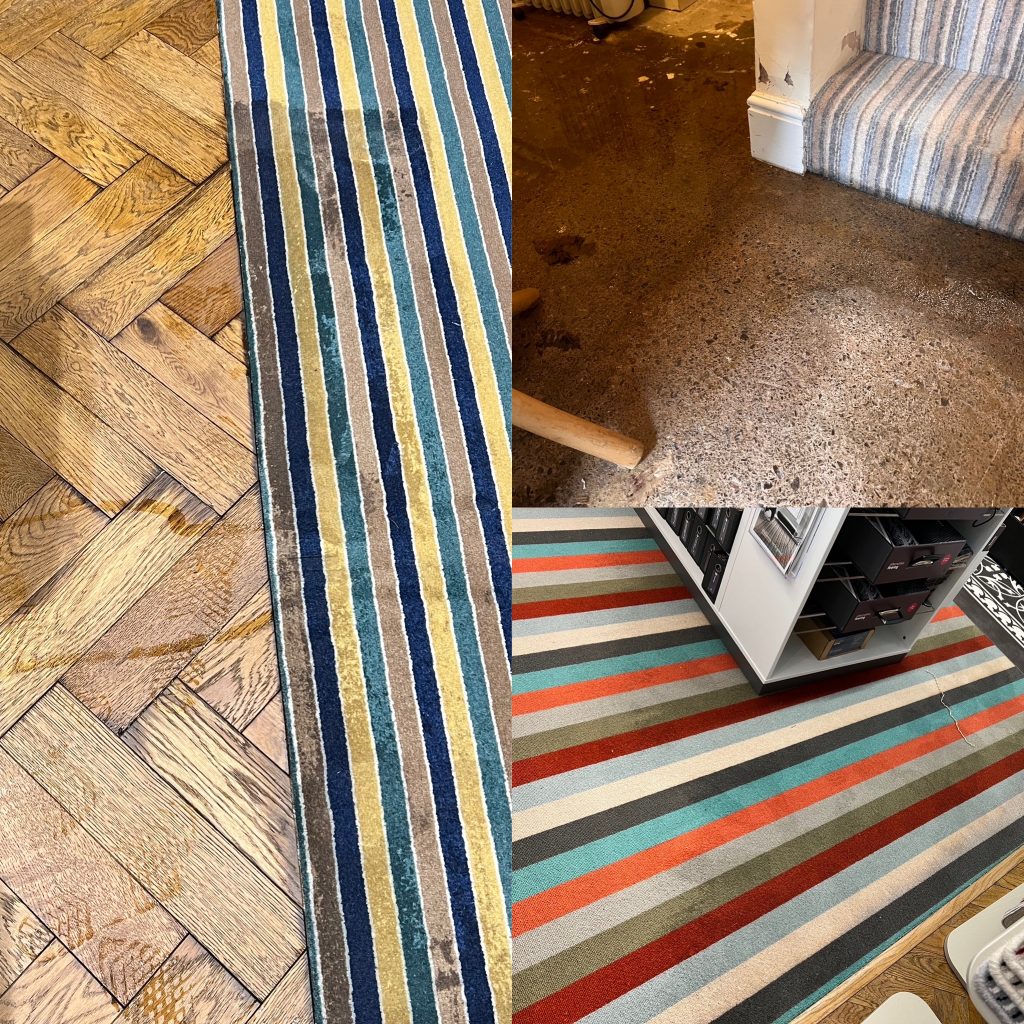A couple of months ago we faced two separate floods in our showroom and down in our basement office. Although we recommend seeking professional help, we thought we could use our experience to pull together some tips about what you can do if you have a flood in your home or business, particularly with some of the April showers we’ve been having!
CLEAR THE AREA
Emptying the affected area as much as possible will speed up the drying process, in particular removing items that soak up and hold onto moisture will help with reducing the ambient humidity. If items of furniture can’t be moved, raising items off the floor on blocks will help; a clearer space will make removing the water from the flooring much easier and increased airflow underneath remaining items will speed up the process.
WET VAC
Using a carpet cleaner or wet vacuum will enable you to draw out most of the water that your carpet holds. However, the flooring you have will affect what you should use and how easy it is to remove the water.
Cut pile carpets are much easier to dry yourself as most machines have brushes and a beater bar which allows you to get to the base of the carpet, and drags the pile back upright, squeezing moisture from the yarn.
A loop pile carpet requires a bit more attention as any machine used must not have a brush or beater bar to avoid fluffing the surface or catching and pulling a row of loops. In this instance, it may be worth speaking to a professional carpet cleaning company from the outset to ensure the correct machine is used.
We got very well acquainted with our Vax and spent several hours going over our two affected showroom carpets until the machine was no longer drawing any more water out. The piece of Deckchair from Adam carpets faired beautifully, and we were able to clean and refit this once dry. Even though it is 80% wool and has darker tones right next to fine white stripes, you wouldn’t realise that it was at one point completely saturated with rainwater.
Unfortunately, the same cannot be said about our 100% wool loop carpet from a different manufacturer, which was much more difficult to get dry because of its closed surface, and as a result, the darker colours did bleed into the cream stripes.
UPLIFT THE CARPET AND REMOVE THE UNDERLAY
Once as much water has been removed as possible, it is worth uplifting the flooring to dispose of or to attempt to preserve it for reuse. Underlay holds water and is difficult to clean, so should be disposed of and replaced, similarly, the metal pins in carpet gripper may rust once wet so it’s advisable to remove these too.
If you are hoping to reuse the carpet, keeping it flat but propped up off the floor will speed up drying as it allows air to reach the subfloor and carpet backing. We managed to do this using a large wooden plank laid across the room but appreciate that this might be hard in a home setting or with a much larger piece of carpet.
It wasn’t practical to do this with a room-sized rug in our basement office where there had been a lot more standing water, so we called on the help of TLC to use their industrial wet vac to dry the rug as much as possible before we rolled and bagged this for them to take away to their warehouse to fully dry and be cleaned.
AIRFLOW
Dehumidifiers are an obvious choice to help dry out a room alongside heaters, but many don’t realise that airflow is equally as important. Placing a few small fans in different directions around the room will agitate the surface of the flooring and speed the process up immensely.
HARD FLOORS
It’s easy to get rid of water on the surface of hard floors but it can be nearly impossible to dry underneath them without completely uplifting the floor. To avoid the disruption of emptying one of our showrooms and uplifting the engineered wood parquet there, we made sure to have a good dehumidifier and heated fans running for a prolonged period to dry the wood out so it could be assessed. We had to remove the carpet tiles in our office to be able to dry the concrete floor underneath and had industrial dehumidifiers running for almost a week to do so in readiness for fitting replacement tiles as, unfortunately, not every floor can be saved.
PROFESSIONAL ADVICE
Dealing with a flood is a stressful time and, ultimately, speaking to a professional (be that flooring, cleaning, or building experts) will give you a much better understanding of any damage that has been caused and the steps required to overcome this. We are always happy to guide you through the process and put you in touch with other experts needed along the way.
Avonvale Carpets. Beautiful Flooring. Fitted Perfectly.

